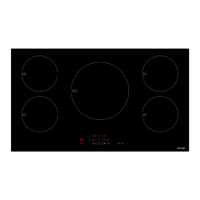13
CLEANING
NOTE: Cleaning and maintenance operations must only be carried out when the cooktop is
cool (all residual heat indicators are off).
The appliance should be disconnected from the power outlet or turned off at your isolation
switch before commencing any cleaning process.
Do not use plastic, plastic coated or aluminium cooking equipment on this appliance.
Cleaning the Cooktop
All cookware used on this appliance should be rated for induction cooking by the manufacturer. Cookware with
rough bases should not be used as they can scratch the glass ceramic surface. The base of the good cookware
should be as thick and flat as possible. Before use, make sure that cookware bases are clean and dry.
Always place the cookware on the cooking zone before it is switched on. If possible, always place the lids on the
cookware. The base of any cookware used must not be smaller or larger than the cooking zones; they should be
the proper size as indicated below, so as not to waste energy. If incorrectly placed, the U symbol will be displayed.
Before cleaning the cooktop, first isolate the cooktop from the power. Once done, ensure that there is no residual
heat stored in the appliance. Vitro-ceramic glass is very resistant to high temperature and overheating. If there is
residual heat stored in the appliance, the related residual heat indicator lamp will be on. In order to avoid burns, let
the appliance cool down.
Remove all spilt food and fat with a clean damp, warm, slightly soapy, dishcloth. Rinse cloth and wipe cooktop
again until clean, then wipe the cooktop dry with a clean tea towel or dry soft cloth.
If aluminium foil or plastic items are accidentally melted on the vitro-ceramic surface, they should be immediately
removed from the hot cooking area with a scraper specifically for vitro-ceramic glass. This will avoid any possible
damage to the surface. This also applies to sugar or food containing sugar that may be spilled on the cooktop.
Enameled steel, aluminium & copper will leave a residue on the surface that should be removed immediately, or
permanent damage may occur.
In the event of other food melted on the cooktop surface, remove the dirt when the appliance has cooled down.
Use cleaner for glass ceramic or stainless steel when cleaning the surface.
Do not use abrasive sponges to clean the vitro-ceramic surface. These materials may damage the surface.
Do not use chemical detergents, sprays or spot removers on the vitro-ceramic surface. These materials may cause
fire or the vitro-ceramic colour to fade. Clean with a damp, warm, slightly soapy, dishcloth.
WARNING: Using cookware that is too large can cause discolouration or damage to the cooktop surface around
the heat zones, which is NOT covered under warranty.

